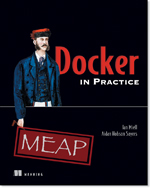This post is based on material from Docker in Practice, available on Manning’s Early Access Program. Get 39% off with the code: 39miell
We’re writing a book on Docker that’s focussed on its practical aspects.
Why? James Turnbull’s “The Docker Book” is a great introduction to Docker for those that want a good grounding in the basics of Docker. And other books like Docker in Action are in the pipe that take you through the standard usage of Docker in detail.
But as busy engineers with day jobs we didn’t have the problem of getting to know Docker. We were sold on it, and wanted to know how to get this thing to useful, and fast. That meant overcoming all sorts of challenges both big and small, from the philosophical to the mundane. And in our own time to boot.
– Do we need to adopt a microservices architecture to make this work?
– Can this solve our capacity issues?
– How do we manage the way this is changing the way we work?
– Is it secure?
– How do we get the typical engineer to understand what’s going on? Where do they get lost?
– The ecosystem is overwhelming and growing every day! How do we navigate it?
– Does this replace VMs?
– What do we do about Configuration Management?
What we lacked was a coherent guide for these real-world problems. We went out and gave talks, built tools, wrote blogs, and lots of them, all with a slant of Docker’s use in the real world.
We first used Docker in anger at work in the fall of 2013. So by the time we were approached to write a book we knew what we wanted to communicate and had had over a year of real-world experience (or “the name we give to our mistakes”, as Oscar Wilde put it) to write up. And there was a happy ending – our organisation embraced Docker and saved a load of money in the process.
Writing a book on Docker is an interesting challenge as it intersects with so many different parts of the software lifecycle. So we cover a broad range of subjects.
The book is divided into four parts:
1) Docker Fundamentals
Where we give a brief introduction to Docker, its use and its architecture
2) Docker and Development
How Docker can be used by developers, some of the benefits, development patterns and pitfalls
3) Docker and DevOps
How Docker fits in with the test, continuous integration, and continuous delivery cycles
4) Docker in Production
Orchestration decisions, aspects of working systems, and how to deal with troubled waters
Each part contains discrete techniques where we discuss solutions to problems we’ve come across, or ideas to maximise the benefits of Docker adoption. But the arc of the narrative is: “Docker from desk to production”.
The book’s now available to buy on the Manning Early Access Program. You can get 50% off the book with the code ‘mlmiell’ and help to shape its content in the author forum.
This is a big technological shift, and we’re excited about being able to be part of it. We’re really interested in your experiences and views on the approach we’ve taken and solutions we’ve found.
The code for the book will be published and maintained here, and Docker images (of course!) available here.
Enjoy!
This post is based on material from Docker in Practice, available on Manning’s Early Access Program. Get 39% off with the code: 39miell


Amusing tweet : #Docker “boils down to downloading an unsigned binary, running it, and hoping it doesn’t contain any backdoor” #CurlPipeSudoBash
http://www.vitavonni.de/blog/201503/2015031201-the-sad-state-of-sysadmin-in-the-age-of-containers.html
http://joeyh.name/blog/entry/docker_run_debian/
Great Post, +1